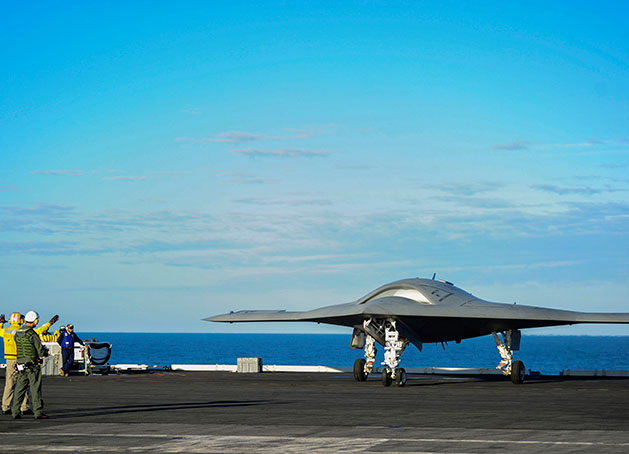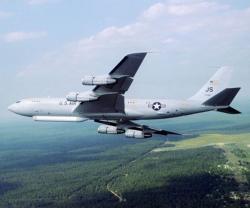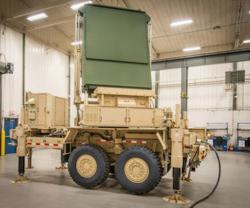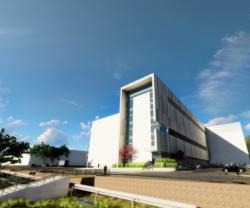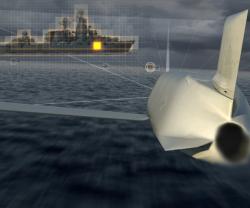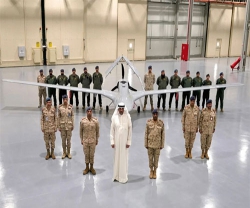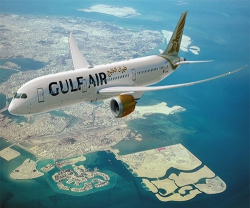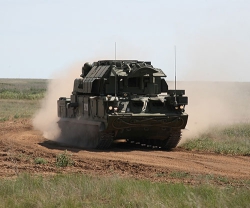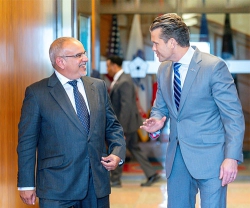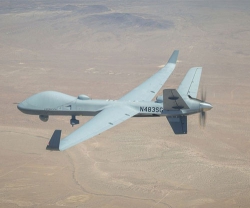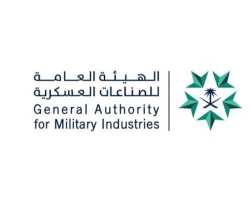NGC, US Navy Complete X-47B Deck Handling Trials
20.12.2012 North America
Northrop Grumman Corporation (NGC) and the U.S. Navy have successfully completed a series of deck handling trials of the X-47B Unmanned Combat Air System (UCAS) demonstrator aircraft aboard the aircraft carrier USS Harry S. Truman (CVN-75).
The exercises, conducted from November 27 to December 17, demonstrated the ability to maneuver the tailless, strike-fighter-sized aircraft quickly and precisely on the flight deck using a wireless handheld controller. They are the latest in a series of test activities leading up to the first carrier landings of the X-47B planned for 2013.
“The X-47B deck trials proved convincingly that the design and operation of the aircraft are fully compatible with the rhythm and operational requirements of the carrier flight deck,” said Mike Mackey, UCAS-D Program Director for Northrop Grumman Aerospace Systems.
“They provided a major boost to the team's confidence as we move steadily toward our first carrier landings next year,” he added.
Northrop Grumman is the Navy's prime contractor for the UCAS-Carrier Demonstration (UCAS-D) program. The company designed and produced two X-47B aircraft for the program. One aircraft was on the ship; the other remains at Naval Air Station Patuxent River where it is undergoing additional shore-based carrier suitability testing.
The deck trials were conducted both while the USS Harry S. Truman was in port at Naval Station Norfolk, and while the ship was under way off the coast of Virginia.
Mackey said the testing included taxiing the X-47B on the flight deck, maneuvering the aircraft up to the ship's catapults using the Northrop Grumman-designed Control Display Unit; taxiing the aircraft over the ship's arresting cables and conducting fueling operations. The team also moved the aircraft up and down the ship's elevators between the flight deck and the hangar bay.
“We proved that the X-47B air system is mature and can perform flawlessly in the most hostile electromagnetic environment on earth, a Nimitz class Navy aircraft carrier,” Mackey added.
In 2013, the UCAS-D program plans to begin conducting shore-based arrested landings of the X-47B at Patuxent River. Carrier trials, which will include both landings and catapult launches, are planned for later in the spring.
Northrop Grumman's UCAS-D industry team includes Pratt & Whitney, Lockheed Martin, GKN Aerospace, Eaton, General Electric, UTC Aerospace Systems, Dell, Honeywell, Moog, Wind River, Parker Aerospace and Rockwell Collins.
Caption: The X-47B UCAS demonstrator taxies on the flight deck of the carrier USS Harry S. Truman (CVN 75) under the direction of a flight deck director ("yellow shirt") and the control of a flight deck operator using a handheld controller to direct the movements of the aircraft.
The exercises, conducted from November 27 to December 17, demonstrated the ability to maneuver the tailless, strike-fighter-sized aircraft quickly and precisely on the flight deck using a wireless handheld controller. They are the latest in a series of test activities leading up to the first carrier landings of the X-47B planned for 2013.
“The X-47B deck trials proved convincingly that the design and operation of the aircraft are fully compatible with the rhythm and operational requirements of the carrier flight deck,” said Mike Mackey, UCAS-D Program Director for Northrop Grumman Aerospace Systems.
“They provided a major boost to the team's confidence as we move steadily toward our first carrier landings next year,” he added.
Northrop Grumman is the Navy's prime contractor for the UCAS-Carrier Demonstration (UCAS-D) program. The company designed and produced two X-47B aircraft for the program. One aircraft was on the ship; the other remains at Naval Air Station Patuxent River where it is undergoing additional shore-based carrier suitability testing.
The deck trials were conducted both while the USS Harry S. Truman was in port at Naval Station Norfolk, and while the ship was under way off the coast of Virginia.
Mackey said the testing included taxiing the X-47B on the flight deck, maneuvering the aircraft up to the ship's catapults using the Northrop Grumman-designed Control Display Unit; taxiing the aircraft over the ship's arresting cables and conducting fueling operations. The team also moved the aircraft up and down the ship's elevators between the flight deck and the hangar bay.
“We proved that the X-47B air system is mature and can perform flawlessly in the most hostile electromagnetic environment on earth, a Nimitz class Navy aircraft carrier,” Mackey added.
In 2013, the UCAS-D program plans to begin conducting shore-based arrested landings of the X-47B at Patuxent River. Carrier trials, which will include both landings and catapult launches, are planned for later in the spring.
Northrop Grumman's UCAS-D industry team includes Pratt & Whitney, Lockheed Martin, GKN Aerospace, Eaton, General Electric, UTC Aerospace Systems, Dell, Honeywell, Moog, Wind River, Parker Aerospace and Rockwell Collins.
Caption: The X-47B UCAS demonstrator taxies on the flight deck of the carrier USS Harry S. Truman (CVN 75) under the direction of a flight deck director ("yellow shirt") and the control of a flight deck operator using a handheld controller to direct the movements of the aircraft.
Previous PostGeneral Dynamics’ 30,000th CSAR Radio Goes to Work
Latest news
Latest events
IDEF 2025 Turkey - International Defence Industry Fair
22 - 27 Jul 2025Istanbul Expo Center - TurkeyDSEI 2025
09 - 12 Sep 2025Excel, London - United KingdomIntersec Saudi Arabia
29 Sep - 01 Oct 2025Riyadh International Exhibition & Convention Centre - Saudi ArabiaDubai International Air Chiefs’ Conference (DIACC 2025)
16 Nov 2025Atlantis, The Palm Dubai - United Arab Emirates

